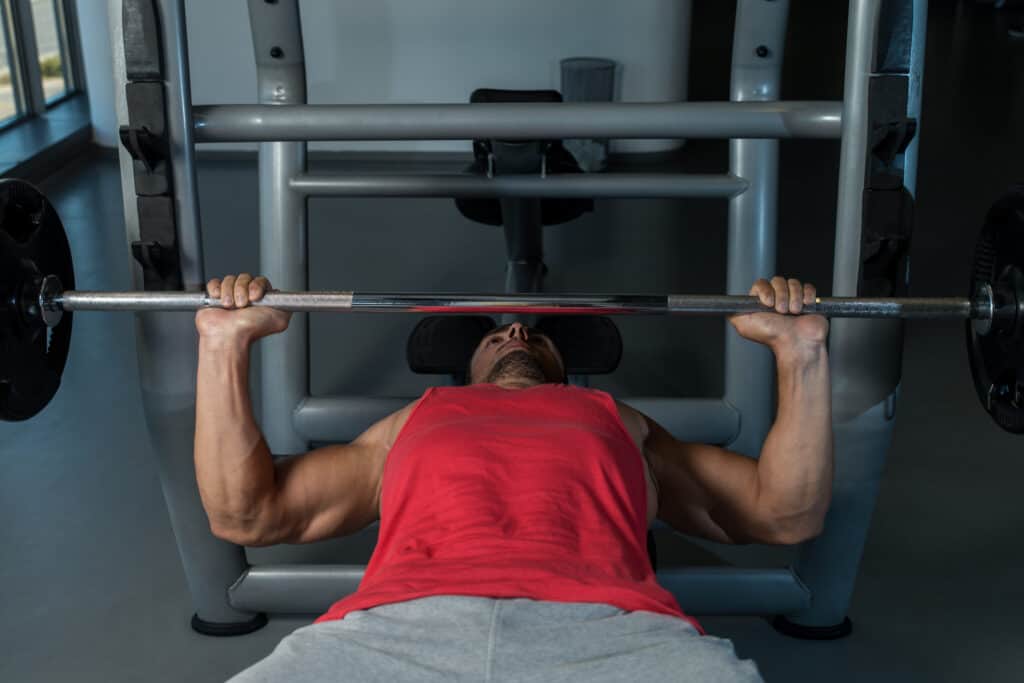Do you know what percentage of your 1-RM (one repetition maximum) is best to increase muscle strength? It is often thought to improve muscular strength, you lift a lower number of repetitions. This is typically 5–8 repetitions at 66–90 percent of your 1-RM. Jefit looked into this question and this is what the research showed.
What is 1-RM Anyway?
The term 1-RM signifies the maximum amount of weight someone can lift for one repetition of a given exercise. When you lift any repetition maximum type of weight, you should not be able to complete additional repetitions. If you can, it’s not a true max set for that particular exercise. The idea is you give everything you have in that first repetition, as the name implies.
Is 1-RM an Effective Way to Test?
Numerous studies have assessed the reliability of the 1-RM test. A 2012 study by Dongguk University in Korea, examined the reliability of the 1-RM test. This was based on muscle group and gender. The researchers reported that 1-RM testing is a reliable measurement to assess muscle strength changes. This was regardless of muscle group location or gender.
In 2009, a study by Victoria University, published in the Journal of Sports Science and Medicine, looked at the reliability of the 1-RM strength test for untrained subjects. Both men and women, aged 18-35 years, participated in the study. They concluded, 1-RM was a reliable method of evaluating the maximal strength in that age group.
As with anything else, it’s important to make sure your body is properly warm-up prior to attempting any max set. This is accomplished by using multiple lighter sets as you “build up” to your 1-RM, final set. Once you have determined a 1-RM in a squat or bench press, for example, you’re then able to work at different intensity levels over time using a specific percent of your 1-RM score. The percentage you work at ultimately depends on what your training goals are.
Examples Using Percentage of 1-RM
The following are just a few examples of how an exercise using percent 1-RM can be expressed:
- 3 x 8 @ 75% – Three sets of 8 repetitions at 75% of the 1-RM
- 8/80%, 6/85%, 6/85%, 4/90% – Eight repetitions at 80%, 2 sets of six repetitions at 85%, and four repetitions at 90% of the 1-RM

Research on 1-RM Percentage Use
A small 2012 study by McMaster University, Canada, published in the Journal of Applied Physiology, compared training effects of light weights to heavy weights. Over a 10-week period, researchers tested the effects of performing leg extensions with either heavy (80 percent of 1-RM) or light (30 percent of 1-RM) weights. The researchers found that both heavy and light loads increased muscle mass equally. But for building strength, the 80 percent load produced superior results.
In a study out of Brazil, researchers looked at the influence of percentage of 1-RM strength test on repetition performance during resistance exercise. The study involved a small group of healthy, male subjects who had been strength training for at least one year. The leg press, Scott arm, and knee flexion were used in this study due to its common use in exercise programs.
The study conclude that in 80 percent and 90 percent of 1-RM, the number of repetitions is higher in exercises involving lower limbs compared with upper limb exercises. While in 70 percent of the cases no differences were found. It seems that single-joint exercises perform less repetitions than multi-joint (e.g leg extension vs. leg press) while upper limbs showed more number of repetitions and total load in 70 percent of 1-RM.
Additional Research
A 2020 review published in Sports Medicine looked at two popular ways to prescribe load for developing maximal strength. The review involved 22 studies comprising a total of 761 participants (585 males and 176 females). The aim of the study was to compare the effectiveness of percentage 1-RM and repetition maximum targets as load prescription methods for the development of maximal strength.
The results showed percent 1-RM elicited greater improvements in maximal strength (4.6%) in comparison with RM targets. More research, however, is needed to fully investigate the efficacy of both these methods, specifically direct comparisons between the two methods.
Finally, Jenkins and colleagues, saw greater increases in muscle activation performing leg extension, to failure, using 80 percent of 1-RM compared to other percent 1-RM over a 6-week period. Maximal muscle activation is important because it’s warranted when trying to increase strength.
Final Thoughts
There are many training variables that need to be managed when trying to increase strength. When it comes to choosing the best percentage of 1-RM to ensure strength gains, the best answer according to the research is probably a range. It will depend also on the training experience of the individual. If someone is a novice and just starting out, research has previously shown as little as 66 percent of 1-RM can do the trick. As a person becomes stronger and more experienced, though, that number increases to about 75 percent. Finally, as the person develops the necessary strength and mobility to handle heavy loads, the percentage can increase once more to 80-90 percent of 1-RM. Here is a great training load chart from the NSCA that can help.
Jefit: The Best App for Building Strength, Power, and Muscle
If you’re serious about building muscle, increasing strength, and developing explosive power, the Jefit strength training app is your ultimate training companion. With over 20 million downloads and 12+ million active users, Jefit is one of the world’s most trusted workout tracking apps. Named the Best Fitness App of 2024 and featured in Men’s Health, PC Magazine, and USA TODAY, Jefit offers expertly designed workout programs, detailed gym performance tracking, and a supportive fitness community to keep you motivated. Whether you want to follow a scientifically proven power training plan, track your progress in real time, or optimize training intensity for faster results, Jefit gives you all the tools you need — in one powerful app. Download Jefit today on iOS and Android to start building strength and power with precision.
- Fibermaxxing: Viral Nutrition Trend You Should Know - December 17, 2025
- Hybrid Metabolic Strength Training for Faster Results - December 10, 2025
- Why Lifters Choose JEFIT App for Real Strength Gains - December 3, 2025
